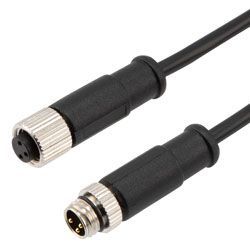Monthly Archives: July 2024
-
Posted: July 03, 2024Author: Steve BowmanRead more »

Some of the most essential products in the harsh environments of industrial connectivity are M8 Ethernet cables and M12 Ethernet cables. Built with features that keep your network up and running, M8 Ethernet cables and M12 Ethernet cables have specific types of connectors commonly used in industrial applications. They are widely deployed in factory automation, machinery, robotics, and other industrial settings where standard Ethernet cables might not be suitable.
Below we explain the main difference between M8 and M12 cable assemblies and list five features to look for as you shop for them. We conclude with two tables to help clarify two designations you will encounter with these products: coding types and pin counts.
M12 vs M8 Ethernet Cables
M12 Ethernet cable assemblies have circular M12 connectors with a 12 mm locking thread diameter, while M8 assemblies have an 8 mm locking thread diameter. Both types provide a robust and reliable connection suitable for industrial environments. The main difference is that the smaller M8 is typically used in applications where space is limited, such as sensors, actuators, and other compact devices.
5 Features of M8 and M12 Ethernet Cables
M8 and M12 Ethernet cable connectors are considered more robust and reliable than other Ethernet connectors primarily because of their design features that cater to industrial and harsh environment applications. Here are the key aspects that contribute to their robustness and reliability:
- Mechanical Durability:
- Threaded Locking Mechanism: Both M8 and M12 connectors use a threaded locking mechanism, ensuring a secure connection that resists vibrations, shocks,
- Cat5e & Cat6e Bulk Cable (36)
- Ecore HDMI Cables (13)
- How To Terminate RJ45 Connectors (3)
- The 5S Advantage (5)
- Network Racks (6)
- Connector (475)
-
USB
(89)
- USB Hubs (10)
-
Splitter
(50)
- Converters (24)
- Power Supply (7)
- Management Bay (2)
- Amplifier (6)
-
Adapter
(369)
- Coaxial (55)
- XLR Cables (11)
-
Tools
(36)
- Instillation Tools (12)
-
Wall Mount
(35)
- Cabinets (4)
-
Cables
(142)
- Pro Audio (82)
- Wall Plate (29)
- BNC (10)
- Wiring Cover (14)
- S-Video (6)
- Video Cables (16)
- Patch Cable (36)
- J-Hook (14)
- Power Cords (41)
- Cat7 (3)
-
Charger
(5)
- Car Charger (4)
- Wall Charger (2)
- Lightning (1)
- Data (4)
- HDMI (13)
- Adapters (1)
- Cat5e (2)
- Cat6 (2)
- Ethernet (31)
- Cat6a (3)
- RJ45 (4)
- Computer Cables (3)
- USB (2)
- FireWire (1)
- Serial (3)
- DIN (3)
- Audio Cables (3)
- 3.5mm (4)
- VGA (3)
- DVI (2)
- Optical Toslink (1)
- XLR (3)
- RCA (2)
- DisplayPort (3)
- telephone (8)
- rj11 (3)
- rj12 (3)
- coiled (0)
- flat (0)
- Coax (9)
- RF (1)
- RG (2)
- Low Loss (LMR) (2)
- fiber optic (8)
- Speaker Wire (2)
- AWG (1)
- labels (0)
- management (4)
- tape (0)
- splice (0)
- techflex (0)
- safety strip (0)
- boot (0)
- heat shrink (0)
- weatherproof (0)
- management (2)
- prep (1)
- support (1)
- extension (3)
- raceway (1)
- duct (1)
- crimp (1)
- Stripper (1)
- Cutter (1)
- surge protectors (1)
- power strips (2)
- How To Terminate Coax Connectors (0)
- antenna (1)
- satellite (1)
- detangler (1)
- DIY (11)
- banana (1)
- switch (3)
- custom (1)
- ShowMeCables (1)
- guide (1)
- Brands (1)
- multi-conductor (1)
- announcement (1)
- patch panel (1)
- keystone (3)
- ceiling mount (3)
- Pinouts (1)
- History (2)
- Certification (3)
- Organization (1)
- null modem (1)
- Television (2)
- DMX (1)
- streaming (0)
- Glossary (1)
- FAQ (1)
- Bulk Cable (1)
- Industrial (1)
- Cybersecurity (1)
- Computer Security (1)

